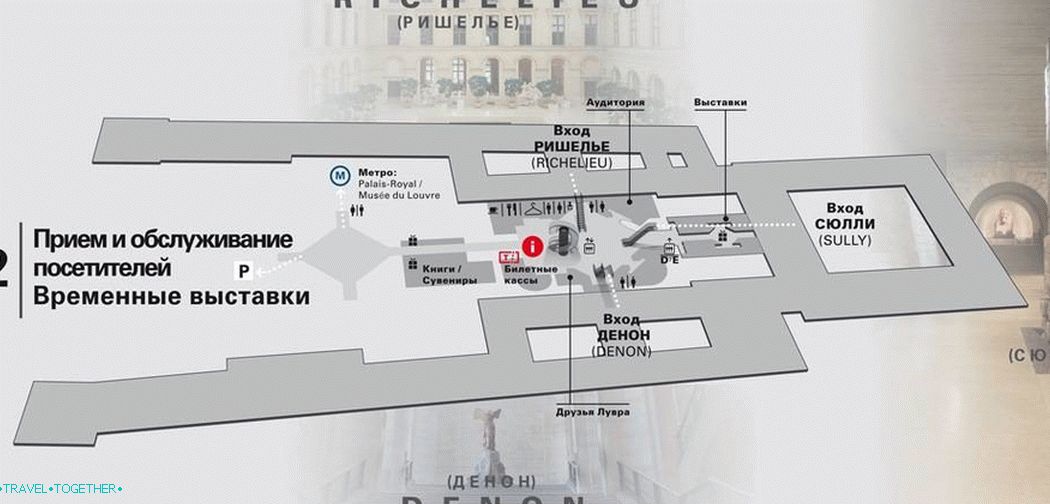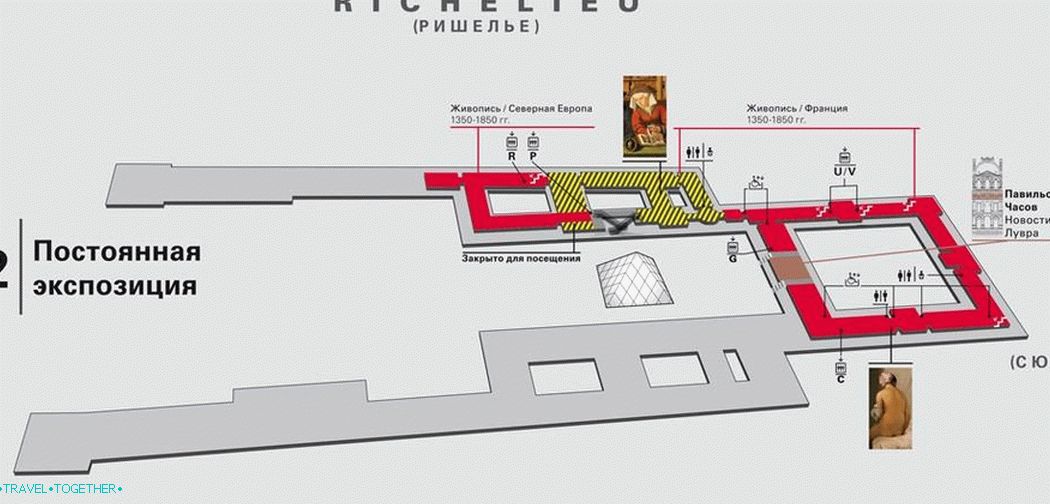Louvre (Paris) – detailed information about the museum with photos. Operation mode Louvre, plans (schemes) and museum collections, where to buy tickets, official site.
Contents
Louvre Museum in Paris
The Louvre is an art museum in Paris, one of the most famous and major museums of the world, which is visited annually by about 10 million person.
The original building of the Louvre Palace is a defensive fortress. in the lower reaches of the Seine, which later became one of the main royal residences.
The Louvre was founded in 1793. The museum is 73,000 sq. meters of art from the Middle Ages to the middle of the 19th century, as well as ancient times. It holds about 35 000 exhibits, some of which are 7,000 years old.
Content:
- Departments
- Collections
- Plans
- Rules of attendance
- Official site
- Operation mode
- Ticket price and where to buy
The building of the Louvre consists of 4 parts, which are called “wings”.
 The Louvre
The Louvre
In the immediate vicinity of the Louvre is the Tuileries Garden – one of the largest and oldest parks in the center of Paris. Great sample of landscape art and the museum of sculptures under the open heaven and also a great place to rest and relax in your heart big city.
Departments of the Louvre
The Louvre is divided into 8 divisions:
- Department of Egyptian Antiquities
- Department of Greek, Etruscan and Roman Antiquities
- Department of Oriental Antiquities
- Department of Art of Islamic Countries
- Painting department
- Department of sculptures
- Graphics department
- Department of Art
Collections
- The Art of the Ancient Near East (7500 BC – 500 year AD) – exhibits found during archaeological excavations are distributed by geography (territory modern Iran, Iraq, Syria, Turkey, etc.). Assembly includes elements of decoration of palaces and temples, statues, signs with inscriptions and luxury goods and introduces one of the first centers of great civilizations. Level 0 – Richelieu’s wing and Sully’s wing
- The Art of Ancient Egypt (4000 – 30 BC) – sculptures and paintings, fragments of temples and tombs, ritual and everyday objects from the Nile Valley – from Egypt to Sudan – presented in the framework of a thematic exposition (level 0), and also as part of chronological exposure from the end prehistoric period before the establishment of Roman rule (level 1). Levels 0 and 1 – Sully’s Wing
- The Art of Ancient Greece (6500 – 30 BC) – exposure, located at levels -1 and 0, is built by chronological principle and reflects the development of ancient Greek art from the end of the prehistoric period to the establishment of the Roman domination. Level 1 presents the material culture of the Ancient Greece and Ancient Rome (items made of bronze, gold and silver, ceramics, glass). Levels -1, 0 and 1 – Denon wing and wing Sully
- The Art of Ancient Rome (100 BC – 500 AD) – at level 0, around the courtyard of the French Queen Anne of Austria (1615-1643), the meeting is presented in chronological order from the end of the Roman Republic before the fall of the Roman Empire. At level 1 The material culture of ancient Greece and ancient Rome is represented. Levels 0 and 1 – Denon’s Wing and Sully’s Wing
- The Art of Ancient Italy and Etruria (900 – 200 years before AD) – sculptures, vases, sarcophagi, weapons, jewelry, interior objects – usually found in tombs – give an idea of the civilizations that preceded the Romans on the territory of modern Italy in the first millennium BC. Level 0 – Denon Wing
- Art of the Middle East and Egypt (30 BC – 1800 AD) – mosaics, reproduced church interiors, painting portraits, earthenware and luxury goods opportunity to get acquainted with the art of the Eastern Mediterranean, in the period from the time of the Roman Empire to the era of Muslim conquests. This series continues the art of the Christian communities of Egypt and Sudan Middle Ages and New History. Levels -2 and -1 – wing Denon
- The art of the Islamic world (700–1800) – objects from ceramics, glass and wood, miniatures, carpets and ceremonial weapons, presented in chronological order from the rise of Islam to XVIII century., Reflect the splendor of civilization, stretching from Spain to India. Levels -2 and -1 – Denon Wing
- Sculpture / France (500-1850 years) – located around the marly and puget courtyards, which represent garden sculptures of the XVII-XIX centuries, chronological exposition covers the period from the Middle Ages to the era of romanticism and introduces the work of the greatest French sculptors, such as Goujon, Bush, Pigalle, Houdon or Bari. Levels -1 and 0 – wing Richelieu
- Sculpture / Europe (500-1850) – European the sculpture is represented geographically: Italy and Northern Europe devoted to chronological exposure at two levels where you can see the works of Donatello, Michelangelo, Canova and others. In a separate Hall are samples of Spanish sculpture. Levels -1 and 0 – wing denon
- Painting / France (1350-1850) – the most complete in The world’s collection of French painting is presented in chronological order and includes paintings by such masters as Poussin, Georges de la Tour, Watteau, Fragonard, Ingres, Corot and others. Monumental canvases XIX at. (David, Delacroix) exhibited at level 1 in the Denon wing. Level 2 – Richelieu’s wing and Sully’s wing / level 1 – Denon’s wing
- Painting / Northern Europe (1350-1850) – painting Northern Europe is presented in chronological order, as well as in according to the geographical foci of culture: Flanders, Germany, Netherlands, etc. Visitors will be able to see Van masterpieces. Eyck, Bruegel, Rubens, Van Dyck, Rembrandt, Vermeer. Level 2 – wing Richelieu
- Painting / Italy (1250-1800) – collection Italian painting, one of the richest in the world, exhibited in Square Hall, the Grand Gallery and adjacent halls. Pictures presented in chronological order and in accordance with geographical centers of culture. Among them are the masterpieces of Fra Angelico, Botticelli, Leonardo da Vinci, Raphael, Titian, Caravaggio, etc. Level 1 – Denon Wing
- Painting / Spain (1400-1850) – exposition located in small rooms around the central hall with monumental canvases. The collection is presented in chronological order from the XV to XIX century. and includes creations of such famous painters like El Greco, Zurbaran, Ribera, Murillo, Goya. Level 1 – Denon wing
- Painting / United Kingdom / United States (1550-1850 d.) – collection of British and American paintings of the Louvre consists mainly of portrait and landscape paintings. Artists such as Gainsborough, West, Rebern, Lawrence, Turner and Constable. Level 1 – Denon Wing
- Decorative Art / Europe (500–1850) – presented chronologically from the Middle Ages to the middle of the XIX century. a collection of luxury items (jewelry, weapons, tapestries, glassware, ceramics, art enamel, products from gold, silver and bronze, precious stones and french treasures crowns, interior objects), as well as recreated interiors reflect a high level of applied art, developed, in particular, thanks to royal orders. Level 1 – Richelieu’s wing, Sully’s wing, Denon’s wing
- Drawings, engravings, prints / Europe (1350-1850 gg.) – this richest assembly in the world is set up in parts, alternately, by reason for the sensitivity of the exhibits to the light. At temporary exhibitions you can see drawings, prints, prints, pastels, watercolors, and manuscripts of the greatest European artists. Level -1 – wing Sully (Rotonda Sully)
- Art of the Peoples of Africa, Asia, Oceania and America (700 BC. – 1900 AD) – meeting, including about one hundred masterpieces from the collection of the Museum on the Branly Quay, presented geographically. Outstanding pieces can be seen in this section. a number of non-European civilizations of pre-Columbian America, Africa, Southeast Asia, Oceania. Level 0 – Denon Wing
Pavilion of Hours: familiarization with the Louvre – precedes inspection of collections and introduces the history of the palace and the museum collection. Around the ruins of a medieval castle is presented the process of gradual turning the palace into a museum. Next, at level 1, favorites works allow to evaluate the diversity of collections. Level 2 dedicated to the modern life of the museum. This introductory route was named after His Royal Highness Sheikh Zayed bin Sultan Al Nahyan, the founder of the United Arab Emirates, as a sign thanks for the invaluable support given to the museum United Arab Emirates.
Small Gallery – here you can learn to understand better artworks and draw knowledge in the field of history arts and various art techniques. Every year A new theme is proposed, which becomes the starting point for acquaintance with the collection of the museum.
Louvre plans
 Entrance to the Louvre
Entrance to the Louvre  Plan Louvre -2 floor
Plan Louvre -2 floor  Plan Louvre -1 floor
Plan Louvre -1 floor  Louvre Plan 0 floor
Louvre Plan 0 floor  Plan Louvre 1st floor
Plan Louvre 1st floor  Plan Louvre 2nd floor
Plan Louvre 2nd floor
Louvre Plan in Russian – download PDF
Rules of attendance
- Keep silence.
- It is forbidden to eat and drink alcohol.
- It is forbidden to take pictures with flash. Some exposure It is generally forbidden to shoot.
 Halls of the Louvre
Halls of the Louvre
Official site
The official website of the Louvre -http: //www.louvre.fr/
 View of the Louvre Palace from the banks of the Seine
View of the Louvre Palace from the banks of the Seine
Mode of the Louvre
The Louvre Museum is open daily, except Tuesdays, from 9.00 to 18.00 Halls close at 5.30 pm Attention, the museum is closed May 1 and 25 December
On Wednesday and Friday the museum is open until 21.45
Ticket prices and where to buy them?
The cost of a ticket to the Louvre – 15 euros. Wednesday and Friday after 18.00 young people (under 26) can get to the museum for free. For this I need only an identity card.
Where to buy tickets online -https: //www.ticketlouvre.fr






